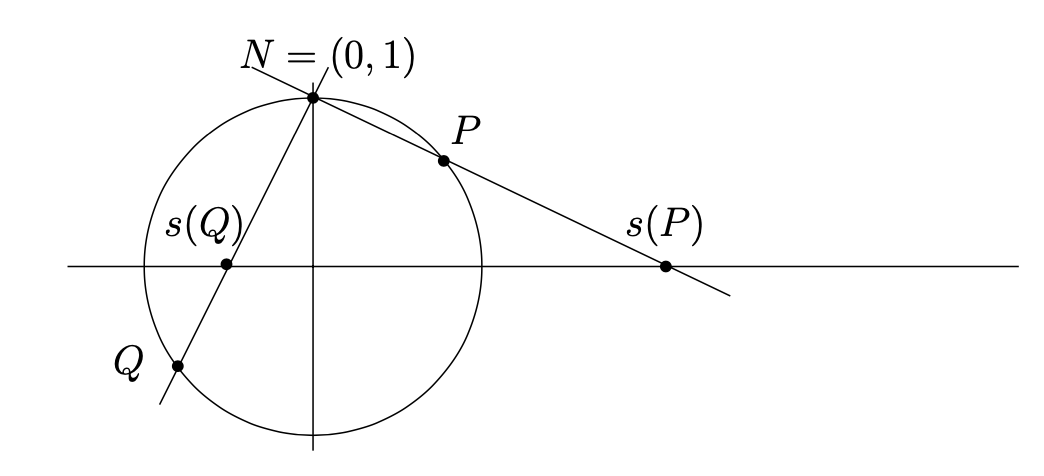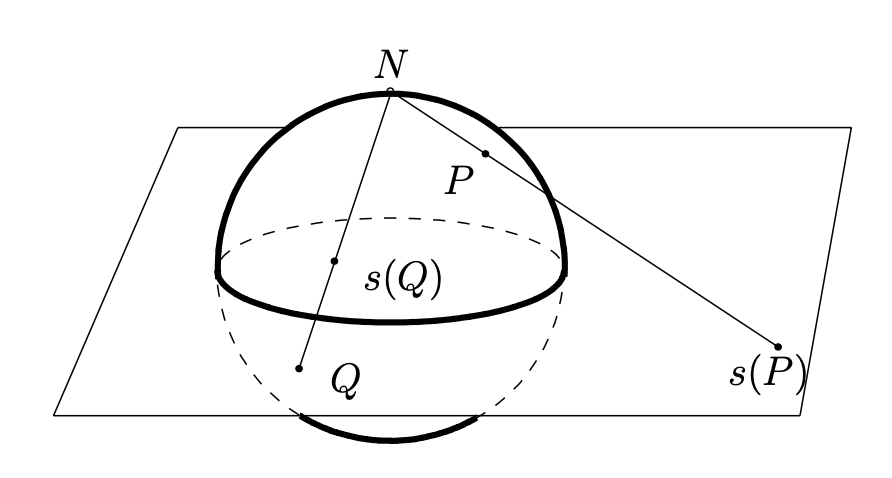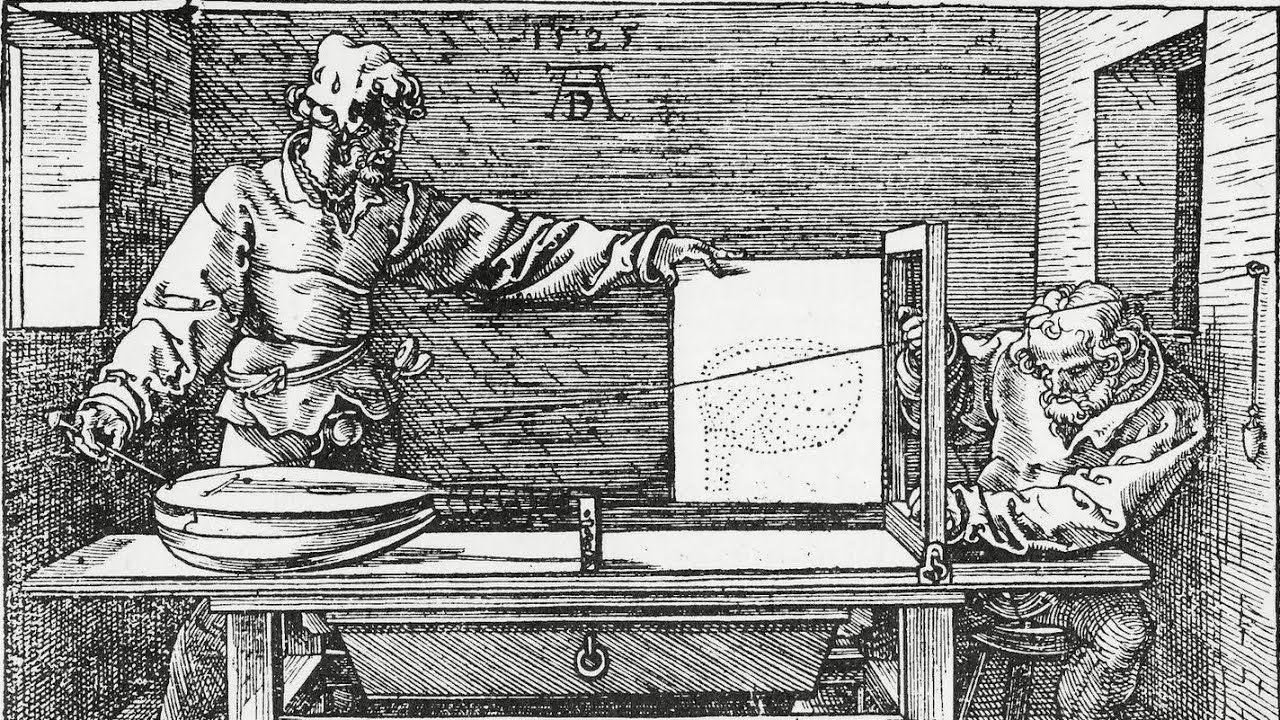Draw the relevant similar triangles and verify the formula \(s(x,y) = \frac{x}{1-y}\text{.}\)
Section 1.3 Stereographic projection
Subsection 1.3.1 Stereographic projection \(S^1\to \extR\)
Let \(S^1= \{(x,y)\in \R^2 \colon x^2+y^2=1\}\) denote the unit circle in the \(x,y\)-plane. Let \(N=(0,1)\) denote the “north pole” (that is, the point at the “top” of the unit circle). Given a point \(P=(x,y)\neq N\) on the unit circle, let \(s(P)\) denote the intersection of the line \(\overline{NP}\) with the \(x\)-axis. See Figure 1.3.1. The map \(s\colon S^1\setminus \{N\}\to \R\) given by this rule is called stereographic projection. Using similar triangles, it is easy to see that \(s(x,y)=\frac{x}{1-y}\text{.}\)

Checkpoint 1.3.2.
We extend stereographic projection to the entire unit circle as follows. We call the set
\begin{equation}
\extR=\R\cup \{\infty\}\tag{1.3.1}
\end{equation}
the extended real numbers, where “\(\infty\)” is an element that is not a real number. Now we define stereographic projection \(s\colon S^1 \to \extR\) by
\begin{equation}
s(x,y) =
\begin{cases}
\frac{x}{1-y} \amp y\neq 1\\
\infty \amp y=1.
\end{cases}\tag{1.3.2}
\end{equation}
Subsection 1.3.2 Stereographic projection \(S^2\to \extC\)
The definitions in the previous subsection extend naturally to higher dimensions. Here are the details for the main case of interest.
Let \(S^2 = \{(a,b,c)\in \R^3\colon a^2+b^2+c^2=1\}\) denote the unit sphere in \(\R^3\text{.}\) Let \(N=(0,0,1)\) denote the “north pole” (that is, the point at the “top” of the sphere, where the positive \(z\)-axis is “up”). Given a point \(P=(a,b,c)\neq N\) on the unit sphere, let \(s(P)\) denote the intersection of the line \(\overline{NP}\) with the \(x,y\)-plane, which we identify with the complex plane \(\C\text{.}\) See Figure 1.3.3. The map \(s\colon S^2\setminus \{N\}\to \C\) given by this rule is called stereographic projection. Using similar triangles, it is easy to see that \(s(a,b,c)=\frac{a+ib}{1-c}\text{.}\)

We extend stereographic projection to the entire unit sphere as follows. We call the set
\begin{equation}
\extC=\C\cup \{\infty\}\tag{1.3.3}
\end{equation}
the extended complex numbers, where “\(\infty\)” is an element that is not a complex number. Now we define stereographic projection \(s\colon S^2 \to \extC\) by
\begin{equation}
s(a,b,c) =
\begin{cases}
\frac{a+ib}{1-c} \amp c\neq 1\\
\infty \amp c=1.
\end{cases}\tag{1.3.4}
\end{equation}
Subsection 1.3.3 Conjugate Transformations
Let \(\mu \colon X\to Y\) be a bijective map. We say that maps and \(f\colon X\to X\) and \(g\colon Y\to Y\) are conjugate transformations (with respect to the bijection \(\mu\)) if \(f = \mu^{-1}\circ g\circ \mu\text{.}\) Exercise Group 1.3.4.3–6 demonstrate examples of this definition for which \(\mu\) is stereographic projection.
Checkpoint 1.3.4.
Exercises 1.3.4 Exercises
Formulas for inverse stereographic projection.
It is intuitively clear that stereographic projection is a bijection. Make this rigorous by finding a formula for the inverse.
1.
For \(s\colon S^1\to \extR\text{,}\) find a formula for \(s^{-1}\colon \extR\to S^1\text{.}\) Find \(s^{-1}(3)\text{.}\)
2.
For \(s\colon S^2\to \extC\text{,}\) find a formula for \(s^{-1}\colon \extC\to S^2\text{.}\) Find \(s^{-1}(3+i)\text{.}\)
Transformations that are conjugate via stereographic projection.
Suggestion: Use Checkpoint 1.3.4 for the exercises that follow.
3.
Let \(f\colon S^1\to S^1\) and \(g\colon \extR\to
\extR\) be given by
\begin{align*}
f(x,y)\amp =(x,-y)\\
g(x)\amp =\begin{cases}1/x \amp x\neq 0,\infty\\
\infty \amp x=0\\
0 \amp x=\infty.\end{cases}
\end{align*}
Show that \(f,g\) are conjugate transformations with respect to stereographic projection.
4.
Let \(R_{Z,\theta}\colon S^2\to S^2\) and \(T_{Z,\theta}\colon \extC\to \extC\) be given by
\begin{align*}
R_{Z,\theta}(a,b,c)\amp =
(a\cos\theta-b\sin\theta,a\sin\theta+b\cos\theta,c)\\
T_{Z,\theta}(z)\amp = \begin{cases} e^{i\theta}z \amp
z\neq \infty\\ \infty\amp z=\infty.\end{cases}
\end{align*}
Show that \(R_{Z,\theta},T_{Z,\theta}\) are conjugate transformations with respect to stereographic projection.
5.
Let \(R_{X,\pi}\colon S^2\to S^2\) and \(T_{X,\pi}\colon \extC\to
\extC\) be given by
\begin{align*}
R_{X,\pi}(a,b,c)\amp =(a,-b,-c)\\
T_{X,\pi}(z)\amp =\begin{cases}1/z \amp z\neq 0,\infty\\
\infty \amp z=0\\
0 \amp z=\infty.\end{cases}
\end{align*}
Show that \(R_{X,\pi},T_{X,\pi}\) are conjugate transformations with respect to stereographic projection.
6.
Let \(R_{X,\pi/2}\colon S^2\to S^2\) and \(T_{X,\pi/2}\colon \extC\to
\extC\) be given by
\begin{align*}
R_{X,\pi/2}(a,b,c)\amp =(a,-c,b)\\
T_{X,\pi/2}(z)\amp =\begin{cases} \frac{z+i}{iz+1}\amp z\neq i,\infty\\
\infty \amp z=i\\
-i \amp z=\infty.\end{cases}
\end{align*}
Show that \(R_{X,\pi/2},T_{X,\pi/2}\) are conjugate transformations with respect to stereographic projection.
7. Projections of endpoints of diameters.
Show that \(s(a,b,c)(s(-a,-b,-c))^\ast=-1\) for any point \((a,b,c)\) in \(S^2\) with \(|c|\neq 1\text{.}\) Conversely, suppose that \(zw^\ast=-1\) for some \(z,w\in \C\text{.}\) Show that \(s^{-1}(z)=-s^{-1}(w)\text{.}\)

